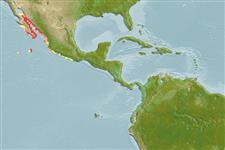>
Blenniiformes (Blennies) >
Chaenopsidae (Pike-, tube- and flagblennies)
Etymology: Acanthemblemaria: Greek, akantha = thorn + Greek, emblema, -atos, anything that is nailed, knocked in; also anything with bass or high relief (Ref. 45335).
Eponymy: Charles Templeton Crocker (1885–1948) was a member of a California family that made its money from railways, having invested in the first transcontinental American railroad. [...] (Ref. 128868), visit book page.
More on authors: Beebe & Tee-Van.
Environment: milieu / climate zone / ระดับความลึก / distribution range
นิเวศวิทยา
เกี่ยวกับทะเล,น้ำเค็ม เกี่ยวกับหินโสโครก; ระดับความลึก 1 - 60 m (Ref. 11482). Tropical; 30°N - 14°N, 115°W - 98°W (Ref. 56266)
Eastern Central Pacific: Gulf of California.
ขนาด / น้ำหนัก / Age
วัยเจริญพันธุ์: Lm ? range ? - ? cm
Max length : 6.0 cm TL เพศผู้/กระเทย; (Ref. 11482)
Short description
เครื่องมือที่ใช้ในการแยกชนิดสัตว์,สิ่งมีชีวิตออกจากกัน | สัณฐานวิทยา | ความยาวต่างๆ
Usually found in shallow, rocky areas (Ref. 37955). Inhabits empty worm and mollusk tubes on rocky reefs (Ref. 11482). Feeds on zooplankton (Ref. 11482), benthic invertebrates and small fishes (Ref. 37955). Spawns in the spring (Ref. 37955).
Life cycle and mating behavior
วัยเจริญพันธุ์ | การสืบพันธุ์ | การวางไข่ | เซลสืบพันธ์ของเพศเมีย(ไข่) | ความดกของไข่ | ตัวอ่อน
Allen, G.R. and D.R. Robertson, 1994. Fishes of the tropical eastern Pacific. University of Hawaii Press, Honolulu. 332 p. (Ref. 11482)
IUCN Red List Status (Ref. 130435: Version 2025-1)
Threat to humans
Harmless
Human uses
เครื่องมือ
Special reports
Download XML
แหล่งที่มาจากอินเตอร์เน็ต
Estimates based on models
Preferred temperature (อ้างอิง
123201): 20.9 - 27.7, mean 25.2 °C (based on 22 cells).
Phylogenetic diversity index (อ้างอิง
82804): PD
50 = 0.5000 [Uniqueness, from 0.5 = low to 2.0 = high].
Bayesian length-weight: a=0.00537 (0.00278 - 0.01038), b=2.95 (2.78 - 3.12), in cm total length, based on LWR estimates for this species & (Sub)family-body (Ref.
93245).
ระดับชั้นอาหาร (อ้างอิง
69278): 3.4 ±0.45 se; based on food items.
Fishing Vulnerability (Ref.
59153): Low vulnerability (10 of 100).
🛈
Nutrients (Ref.
124155): Calcium = 162 [78, 300] mg/100g; Iron = 0.889 [0.512, 1.566] mg/100g; Protein = 17.9 [16.7, 19.0] %; Omega3 = 0.116 [0.060, 0.218] g/100g; Selenium = 24.2 [10.5, 54.4] μg/100g; VitaminA = 330 [106, 1,083] μg/100g; Zinc = 2.1 [1.3, 3.1] mg/100g (wet weight);
